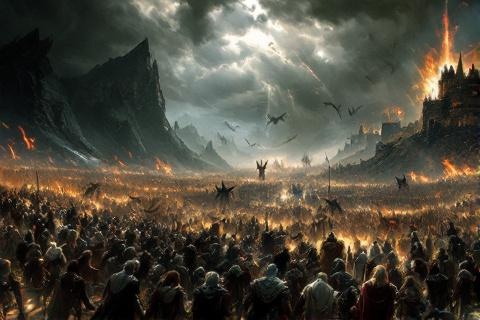
The Battle of Unnumbered Tears
The Most Tragic Defeat
Origins of the Battle
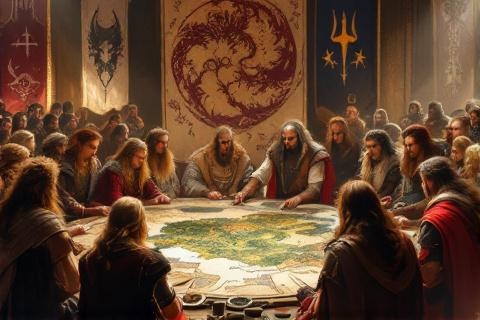
In the years following the Dagor Bragollach,
Maedhros son of Fëanor recognized the need for a united
front against Morgoth's growing power. Through careful
diplomacy and shared purpose, he formed what became known as the Union of
Maedhros, bringing together the scattered forces of the Noldor,
the Edain of East Beleriand, and the
Dwarves of the Blue Mountains. This alliance represented the
greatest coalition of Free Peoples since the First Age began, with even the
Green-elves of Ossiriand joining the cause.
Morgoth's dominion had grown considerably since his victory in the Dagor
Bragollach, with his forces occupying much of northern Beleriand. His armies of
Orcs raided freely across the lands, while his spies and agents
worked to undermine the remaining Elven realms. The Dark Lord's power had
reached such heights that many believed this would be their last chance to
challenge his rule before he overwhelmed them completely.
The planning for the assault spanned several years, with Maedhros carefully
coordinating the roles of each allied force. The strategy called for a massive
pincer movement, with armies advancing from both east and west to trap Morgoth's
forces between them. The western host would be led by High King Fingon, while
Maedhros himself would command the eastern forces, timing their attacks to catch
the enemy in a devastating crossfire.
The Forces Gather
The armies of the Union gathered in tremendous numbers across the plains of East
and West Beleriand, representing the greatest military force the
Elves and their allies had ever assembled. From the west came the
hosts of Hithlum under Fingon, joined by the men of
Dor-lómin led by Húrin and Huor, while from the east marched
the sons of Fëanor with their followers and the
Eastern forces of Men, including the people of Bór and Ulfang.
Morgoth's response to this gathering threat was to amass an army of
unprecedented size within Angband. His forces included
countless Orcs organized into specialized units, armor-clad Trolls bred for war,
werewolves, and most terrifyingly, a host of fire-drakes led by
Glaurung the Golden, now grown to full magnitude of his
terrible power. Gothmog, Lord of Balrogs, would serve as the supreme commander
of these dark forces.
The Union positioned its forces strategically across the plain of
Anfauglith, with Fingon's host concealed in the western
valleys of the Ered Wethrin, while Maedhros and his allies took position in the
eastern regions near the hills of Himring. The plan called for Maedhros to
signal the start of the battle with a great fire, at which point both armies
would advance and crush Morgoth's forces between them.
The Opening Moves
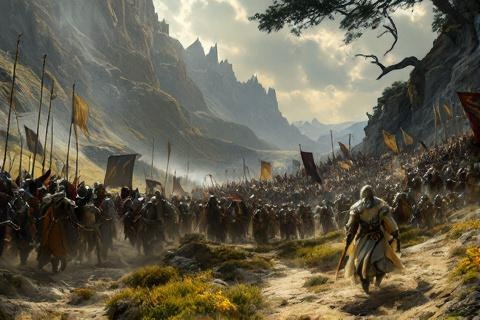
The carefully laid plans began to unravel when Morgoth, aware of the Union's
strategy through his spies, sent a force to provoke Fingon's army. Upon seeing a
small group of Orcs seemingly torturing Gelmir, brother of Gwindor of
Nargothrond, Gwindor broke ranks and charged with his
company, forcing Fingon's hand before the agreed-upon time. This premature
assault disrupted the entire battle plan and sent thousands of warriors rushing
across the plains of Anfauglith.
Maedhros and his forces, still preparing their advance from the east, were
caught unaware by the western attack. The delay proved costly, as it allowed
Morgoth's forces to engage the two armies separately rather than being caught
between them as planned. This separation would prove to be a crucial factor in
the battle's eventual outcome.
Despite the premature nature of the attack, the initial western assault achieved
remarkable success. Gwindor's charge, followed by Fingon's host, broke through
the first lines of Morgoth's defense with such fury that they reached the very
gates of Angband. The Orcs fled in terror before the onslaught, and for a brief
moment, it seemed victory might be possible.
The Betrayal of Men
The tide of battle turned catastrophically when Uldor the Accursed, leader of
the Easterlings who had sworn allegiance to Maedhros, revealed his true loyalty
to Morgoth. At a crucial moment in the battle, Uldor and his followers turned
their weapons against their allies, attacking the sons of Fëanor from behind
while they were engaged with Morgoth's forces. This betrayal threw the eastern
flank into chaos and prevented Maedhros from joining with Fingon's forces.
The treachery of the Easterlings had devastating consequences for the eastern
front of the Union's army. Many of Maedhros' best warriors fell in those first
moments of betrayal, caught completely by surprise as their supposed allies
attacked them. The confusion and disorder spread rapidly through the ranks,
making any coordinated response impossible and leaving the eastern flank
vulnerable to Morgoth's counter-attack.
Not all the Easterlings proved false, however, as Bór and his sons remained
loyal to their oaths. They fought valiantly against their kinsmen, engaging
Uldor's forces in fierce combat. Bór and his sons fought to the death defending
their Elven allies, proving that even in this darkest hour, some Men remained
true to their word. Their sacrifice, though noble, could not stem the tide of
disaster that the broader betrayal had unleashed.
Dragons Enter the Fray
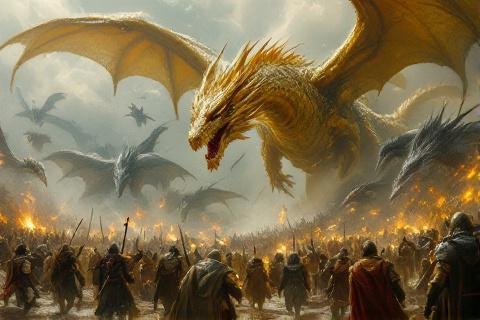
The arrival of Glaurung the Golden, Father of Dragons, marked another turning
point in the battle. Leading a host of fire-drakes from Angband, Glaurung
emerged onto the battlefield with devastating effect. His massive form and the
heat of his presence alone caused panic among the troops, while his fire brought
death to hundreds with each breath. The dragons' assault completely changed the
dynamics of the battle, introducing a level of terror and destruction that the
Union's forces had not prepared for.
The disciplined formations of the Elvish armies, maintained even through the
chaos of betrayal, finally broke under the dragons' onslaught. Glaurung and his
brood drove deep wedges between different sections of the army, isolating units
from each other and preventing any coordinated response. The careful battle
plans of the Union crumbled as commanders lost contact with their troops and
entire companies were scattered across the battlefield.
The effects of dragon-fire transformed the battlefield into an inferno. The
intense heat made it impossible for warriors to maintain their positions, while
the smoke and ash obscured vision and choked the air. Armor became too hot to
wear, weapons too painful to grasp, and many soldiers fell not to the dragons'
teeth or claws, but to the unbearable heat and toxic fumes that swept across the
plain of Anfauglith.
The Stand of the Dwarves
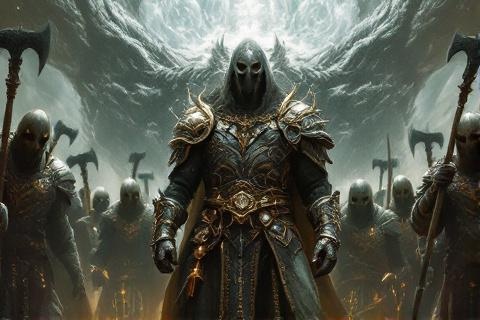
In one of the battle's most memorable moments, Lord Azaghâl of Belegost and his
Dwarven warriors directly confronted Glaurung the Dragon. The Dwarves of
Belegost, wearing great masks that allowed them to withstand the dragons' fire
better than Elves or Men, formed a steel ring around their lord as he faced the
Father of Dragons. Their unique armor and natural resistance to heat enabled
them to stand firm where others had fled.
During this confrontation, Azaghâl managed to strike Glaurung with his powerful
weapon, inflicting a serious wound that forced the great dragon to flee the
battlefield. This remarkable feat marked one of the few successful attacks
against the mighty dragon in all his years of terror. The wound, while not
fatal, proved that even the mightiest of Morgoth's creatures could be hurt.
The victory came at a terrible cost, as Glaurung in his pain and fury crushed
Azaghâl beneath his bulk. The Dwarf-lord's sacrifice inspired his followers to
recover his body in a display of desperate courage. The Dwarves of Belegost,
carrying their fallen lord's body, withdrew from the battle in a slow, orderly
fashion, singing deep dirges that echoed across the battlefield. None of
Morgoth's forces dared to interfere with their departure.
Hurin's Last Stand
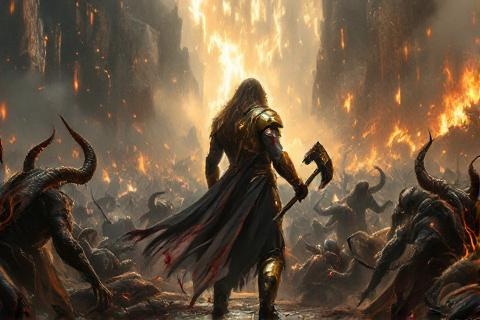
As the battle turned against them, Fingon's forces began a fighting retreat
toward the Pass of Sirion and the Fen of Serech. The withdrawal quickly became
chaotic as different units tried to maintain cohesion while under constant
attack from Morgoth's pursuing forces. The armies of Hithlum fought desperately
to prevent their retreat from becoming a rout.
In this dire situation, Húrin and the Men of Dor-lómin demonstrated
extraordinary courage by positioning themselves as a rear guard. These valiant
warriors held their ground against overwhelming odds, allowing thousands of
their allies to escape through the pass. Their sacrifice bought precious time
for the retreating forces, though at a terrible cost to themselves.
The last stand at the Fen of Serech became legendary in the annals of the First
Age. Húrin's men formed a living wall against Morgoth's forces, refusing to
yield even as their numbers dwindled. They fought with such ferocity that the
enemy had to pay dearly for every step of advance through the marshland.
Even as his men fell around him, Húrin's defiant cry of 'Aurë entuluva!' ('Day
shall come again!') rang out across the battlefield. He repeated this cry
seventy times before being finally overwhelmed, each shout a declaration of hope
in the face of darkness. This act of defiance would be remembered as one of the
most powerful moments in the entire history of the First Age.
The Death of High King Fingon
High King Fingon found himself cut off from the main body of his forces as
Morgoth's armies drove wedges between the allied units. His personal guard
fought valiantly to protect their king, but they were gradually surrounded by
enemies pressing in from all sides. The isolation of the High King from his
troops marked a critical moment in the battle's final phase.
The arrival of Gothmog, Lord of Balrogs, with his company of fire-demons shifted
the balance decisively. The High Captain of Angband personally led the assault
on Fingon's position, bringing with him the most terrifying of Morgoth's
servants. The presence of multiple Balrogs on the battlefield created a
nightmare scenario for the already beleaguered Elven forces.
The combat between Fingon and the Balrogs was one of the most dramatic
encounters of the entire battle. Though Fingon fought with incredible skill,
matching Gothmog blow for blow, the arrival of a second Balrog sealed his fate.
The High King was finally struck down from behind while engaged with Gothmog,
and the Lord of Balrogs ended his life by cleaving his helmet. Thus fell the
valiant High King of the Noldor, his body beaten into the dust by the Balrogs'
weapons.
The Retreat of the Sons of Fëanor

The eastern forces under Maedhros, already reeling from Uldor's betrayal, found
themselves in complete disarray as news of the western army's defeat reached
them. The carefully planned pincer movement had failed entirely, and now
Morgoth's forces threatened to encircle them completely. The sons of Fëanor and
their remaining loyal troops faced the real possibility of total annihilation.
Maedhros, recognizing the battle was lost, ordered a withdrawal toward Mount
Dolmed. This retreat, while necessary, was costly and difficult, with many
warriors falling to pursuing enemies or becoming separated from the main force.
The sons of Fëanor fought desperately to keep their remaining forces together
during the withdrawal.
Various Elven groups managed to survive by scattering into smaller bands and
using their knowledge of the land to evade capture. Some found refuge in the
forests of Ossiriand, while others made their way south to Nargothrond or east
over the mountains. These scattered survivors would carry the tale of the
battle's horror to all corners of Beleriand.
Aftermath and Consequences
The losses suffered by the Free Peoples in the Battle of Unnumbered Tears were
catastrophic and far-reaching. The flower of the Noldorin warriors was
destroyed, with countless noble houses losing their lords and heirs. The armies
of the Edain were virtually annihilated, with the exception of a few scattered
survivors. The military might of the Elves and their allies in Beleriand would
never recover from this devastating defeat.
Among the most significant outcomes was the capture of Húrin by Morgoth's
forces. Brought before the Dark Lord in chains, Húrin refused to reveal the
location of Gondolin or submit to Morgoth's will. In
response, Morgoth placed a terrible curse upon Húrin and his family, forcing him
to watch through Morgoth's own eyes as tragedy befell his children. This curse
would lead to some of the most tragic tales of the First Age.
Morgoth's victory in the battle allowed him to consolidate his dominion over
Beleriand more firmly than ever before. The Dark Lord's armies now moved freely
across the northern regions, and his influence spread further south than ever
before. The remaining free peoples were forced to adopt increasingly defensive
positions, abandoning any hope of directly challenging Morgoth's power.
Legacy of Tears
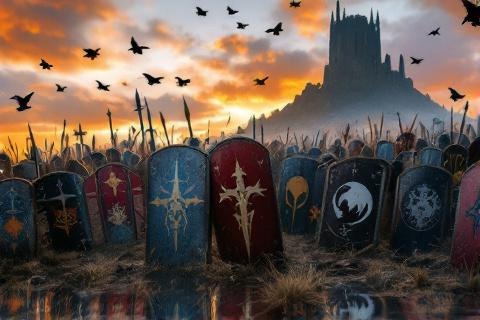
The battle's outcome had immediate and severe consequences for the remaining
Elven realms. Hithlum fell under the dominion of Easterlings who had served
Morgoth, while the sons of Fëanor were driven to the margins of Beleriand. The
hidden city of Gondolin became even more isolated, and Nargothrond adopted a
policy of secrecy and guerrilla warfare. The proud kingdoms of the Noldor were
reduced to scattered refuges and hidden strongholds.
The Battle of Unnumbered Tears stands as the most catastrophic defeat in the
history of the First Age, marking the point where the power of the Noldor was
irrevocably broken. This battle demonstrated the futility of directly
challenging Morgoth's military might and showed how deeply his corruption had
spread among Men. The betrayal of the Easterlings would long be remembered as a
bitter lesson about the frailty of alliances.
The long-term effects of this battle would shape the remainder of the First Age
and beyond. The defeat led to the abandonment of large-scale warfare against
Morgoth, with future resistance taking the form of individual heroic deeds and
small-scale operations. The battle's outcome convinced many Elves that victory
over Morgoth could only come through divine intervention, leading to
Eärendil's eventual journey to seek the aid
of the Valar.
